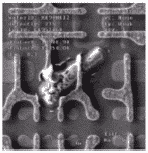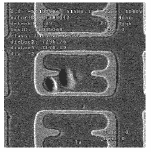Hello everyone and welcome to this post on impact of defects and measuring defect levels.
The learning objectives are to be able to discuss the impact of defects in a process.
To discuss the importance of a low fraction defective per part for complex products. Then to understand the difference between a defect and a defective part.
This will also help us to understand the terms defect per unit or DPU, and defect per million opportunities or DPMO.
But first,
What do we mean by the word defect?
We’re going to say that, a defect occurs during any process, when the outcome of the process is not our expected outcome.
And what we mean by that, is that the expected outcome is the outcome that, we have specified in advance.
It’s what we want the process to produce and if a defect occurs, then the outcome of the process will not be as we expected.
In other words, a defect is a Flaw or an error or a discrepancy. And just to put this into a little more visual context, here are some defects example work.
Random Defects: unwanted particles


Systematic Defects: process problem


Here in above pics, we have some random defects. Some particles not deposited on the semiconductor wafer, these could potentially cause the integrated circuit, the chip not to work.
Next, we have also same thing, silicon wafers with here, some systematic defects. Here, we have gauges for example. In the film or lines that are not printed correctly, they’re also unwanted. And they’re not part of the specified outcome of the process. And then, could cause a defective part.
Now, let’s look together at a simple process for making crayons.

The two basic ingredients for crayons are; paraffin wax and pigment color.
These are then mix and store and heat gallon tanks which I didn’t put here and then they’re heated.

This is a storage facility, they’re heated up very very hot and melted and then, poured into a mold of crayon shaped holes, and a single mold can make over a thousand crowns at a time. For example, You then cool the mold, and then an operator will use hydraulic pressure to eject the crayons, from the mold and then, they’re label and packaged. And so, a crayon manufacturer a big one could produce two to six millions crayons in a day.
Now, in cost perspective we see what is impact of defect to company.
Why worry about a few defects? & Impact of defect
You’re the manager of a crayon manufacturer, out of a hundred batches of paraffin wax and color pigment used for the crayons, an average of one batch does not match design specifications.

When you find out about a bad batch, you need to scrap around 40 batches but you estimate that the scrap costs are very low.
In fact, the scrap costs for this 40 batches is less than 0.05% of the cost of goods sold, extremely small.
So you say, the problem is under control.
Now, as a quality engineer and from a quality perspective, are there any flaws in your thinking?
let’s look at this together.
So here, we see our crayon flow again, now, a defect is produced somewhere in our process. Let’s just arbitrarily draw defect occurs and this leads to in my example, to a defective crayon, defective crayon, defective product or if we were service process, would be defective service.
Where are our costs here?
Now, before the defect occurs, you have costs due to the materials.
Even though, we scrap the batches we know that it’s a small amount of money.
But, where else do we have costs?
Internal Failure cost
Well we have also the labor, that went into making that crayon.
So the people that we’ve hired for our process, they’re there to make the products and we’re paying them for making parts that we cannot sell.

Now, the other interesting thing is, if we have a process where we have a high demand and we have a capacity constrained process, then we’re using on both cases even if it’s not capacity straight, we’re using up capacity on machines, we’re using up the energy costs for example, for heating up the mixture, the molding machine, we’re molding products that could potentially not sell.
So the capacity is being used up and this can be critical when we have a capacity constrained process, which means we need every single part of our capacity every minute of our capacity, we need to make good parts to meet the demand.
So these though, in this part of the factory, the main impact of defect we’ve got internal failure costs. Which although they may be small, they’re very real.
External Failure cost
Now the other problem is that, we have this defective crayon, and this defective crayon might end up getting out to the customer.
Now, the case of crayons maybe is not that critical depends if there’s something toxic in it or something then it would be critical but you can think of this applied to something like to another product like our car or like some kind of medicine.
That defective product gets out to the customer, we have for example, warranty cost, liability cost. We could have even worse, recall cost, we could even badly have the loss of reputation and loss of reputation leads to things like lower prices;
We’re force to sell our products at a lower price or even loss of market. The demand will drop, and these are name as then the external failure costs. And these external failure costs are often underestimated. So even if you’re arguing that the scrap or the material is not that much there’s other things you need to think about, and one of the most important ones is what happens if that defective part gets out to the market.

And there’s one more thing here, can you think more impact of defect, one more problem.
It’s the idea that if you allow one batch of a hundred, so one batch of a hundred looking at 1% of poor material, if you allow that you are creating a culture; 1% defective are ok. And what we’re going to see very soon is that, even a small percentage of defectives can accumulate to very very substantial failure rates for an entire process.
And these are crayons, we just have a few parts, what if you have a very complex process?
If its so then the impact of the defect will be huge.
Read more about Cost of Quality by click here.
Find more jobs and technical news.






